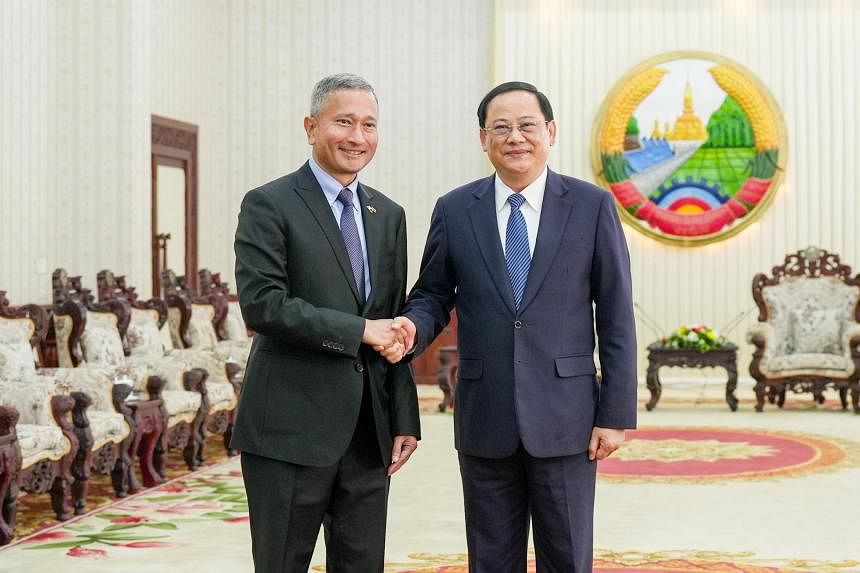VIENTIANE, Laos – Laos has enormous economic potential despite its fiscal difficulties and will thrive if the right infrastructure and policy frameworks are in place, said Singapore’s Foreign Minister Vivian Balakrishnan during his official visit to the country.
Speaking to reporters on Jan 27, he said that Singapore can work closely with Laos to maximise its economic potential through education and training, as well as provide assistance to help it plug into the global markets, including in the sale of carbon credits.
Over the course of the day, Dr Balakrishnan met Lao Prime Minister Sonexay Siphandone, Foreign Minister Saleumxay Kommasith and the head of the Lao People’s Revolutionary Party external relations committee, Mr Thongsavanh Phomvihane.
Laos, one of the world’s few remaining communist states, is currently grappling with slowing growth, rising debt and inflation that averaged 31.2 per cent in 2023.
“They have also been quite open and candid that their fiscal circumstances have also been quite tight. And yet they do want to move forward, and they want to look at the opportunities,” Dr Balakrishnan told reporters of his discussions with the senior Lao leaders.
“We are now at the start of another technological revolution characterised by advances in artificial intelligence, quantum computing, digitalisation, synthetic biology and the need for renewable energy to create a more sustainable and safe world.”
These present opportunities for Laos, which has plentiful supplies of renewable energy, especially hydropower, that can be a source of carbon credits.
“As the world moves and tries to achieve a genuinely zero emissions target in 2050, you are going to need the resources and the availability of what Laos has to offer, particularly in the carbon credit trading space,” he said.
Laos also has significant deposits of rare earths needed in the electronics industry, and it is a net food exporter.
“If you again project forward a world facing climate change, floods, droughts and potentially food crises in the future, a place like this – with plentiful land and fertile land, at that – if they can step up their agricultural productivity, they can certainly be another source of food and contribute to food security in Asean as well,” said Dr Balakrishnan.
Singapore, meanwhile, needs energy, carbon credits and food – which offers potential for collaboration between the two countries.

Singapore started importing hydroelectricity from Laos through existing infrastructure in Thailand and Malaysia in June 2022.
The Lao PDR-Thailand-Malaysia-Singapore Power Integration Project allows Singapore to buy up to 100MW of hydropower over a two-year period. The four countries are discussing how to expand this project, including by possibly enhancing its capacity.
Both countries are also in discussions on how carbon credits can be transferred to help nations meet their climate targets in a way that meets requirements under Article 6 of the Paris Agreement, an international treaty on climate change adopted in 2015.
Dr Balakrishnan said: “You need to set up not just the physical infrastructure, but the policy and legislative frameworks cross-border and preferably Asean-wide in order to enable the sustainable and win-win commercial arrangements for these sorts of exports to occur.”
Singapore can also work closely with Laos to enable it to export carbon credits, he said.
He called these examples “the tip of the iceberg” that illustrates “there is potential and there are sensible rational arrangements that can be made bilaterally, regionally, Asean-wide, which will unlock the potential for Laos and also expand opportunities for Singapore and Singaporeans”.
In September 2022, then Lao Prime Minister Phankham Viphavanh visited Singapore, where he signed four memorandums of understanding on cooperation in areas like environmental protection and energy.
In the Laotian capital of Vientiane, Dr Balakrishnan attended a reception for Lao alumni of the Singapore Cooperation Programme at the Crowne Plaza hotel on Jan 27.
Under the programme, more than 16,000 Lao officials, including Mr Thongsavanh and Lao President Thongloun Sisoulith, have attended Singapore-run training courses on subjects like the English language, e-commerce and sustainable development since 1992.
This reception for Lao officials was held in conjunction with the 50th anniversary of the establishment of diplomatic relations between Singapore and Laos.
To support Laos’ work chairing Asean in 2024, Singapore also launched customised capacity-building courses for Lao officials on subjects such as speech writing and communication skills – which Mr Saleumxay thanked Dr Balakrishnan for during their meeting.
The Singapore Foreign Minister, who also met Singaporeans living in Laos during a tea reception, thanked them for helping the local communities and enhancing the level of goodwill for Singapore among Laotians.
Among the Singaporeans who met the minister was Ms Lim Jue Hui, 35, assistant director of a private institution called Sunshine School in Laos. She has noticed that many Laotians look up to Singapore.
“Many of my students want to study in Singapore other than Australia and the United States,” she told The Straits Times.
As part of his three-day visit, Dr Balakrishnan will attend the Asean Foreign Ministers’ Retreat in Luang Prabang on Jan 29. The ministers are expected to discuss ways to deepen regional integration and maintain an inclusive and stable regional order together with Asean’s external partners.


